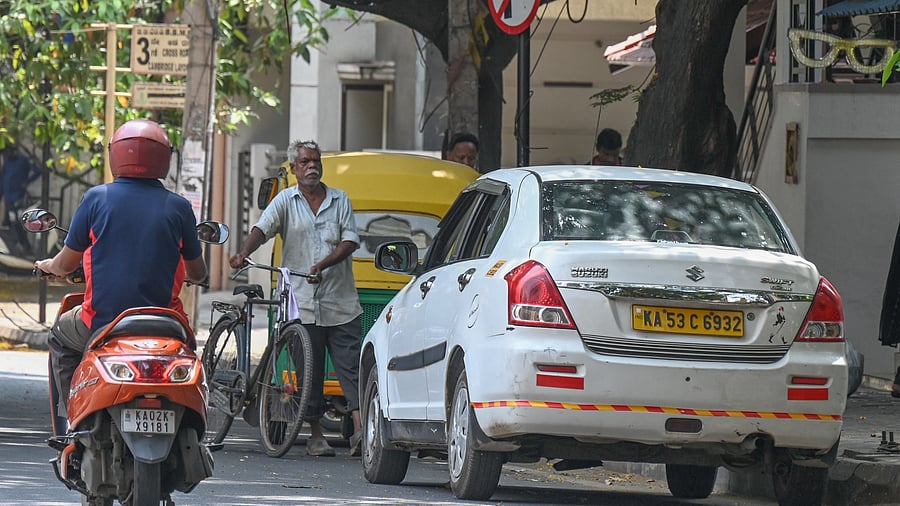
With few designated zones, people park their vehicles wherever space is available.
Credit: DH PHOTO/S K DINESH
Bengaluru: With the city’s Parking Policy 2.0 gathering dust and virtually no on-street parking enforcement, Bengaluru’s roads have long borne the brunt of haphazard parking and resultant traffic congestion.
The Directorate of Urban Land Transport (DULT) prepared Parking Policy 2.0 in 2021, after the first plan was implemented by the BBMP in 2012. However, the city’s rapid growth demanded a relook at the policy. The conversion of many areas from residential to commercial use without compliance with parking norms, and the increasing vehicular population, prompted this move.
The policy suggested area-level parking management plans, streamlining on-street parking, regulating residential parking, introducing paid parking, and adopting technology to enforce parking rules.
“On-street parking is prohibited around mass transit stations, TTMCs/major BMTC terminals, and multi-level parking complexes (MLCPs). No parking is allowed on narrow residential roads where circulation would be hampered,” according to the policy.
It also suggested the introduction of an annual residential parking permit: less than Rs 1,000 for small cars, between Rs 3,000 and Rs 4,000 for medium cars, and Rs 5,000 for MUVs and SUVs.
However, the policy has not been implemented, meaning effective regulation of parking still relies heavily on enforcement of the Motor Vehicles Act for violations. With no clearly designated parking zones and more ‘No Parking’ signs than boards indicating where parking is permitted, people are more likely to park wherever space is available.
Roadside parking persists
Several roads, especially major corridors such as Ballari Road, Tumakuru Road, Old Madras Road, and Old Airport Road, have been designated as ‘no-parking’ zones. However, roadside parking persists. Areas that are both commercial and residential face severe traffic congestion, with vehicles parked haphazardly on both sides of the road, reducing road space, especially in the bylanes.
Krishna Panyam, a resident of 15th Cross Road, Malleswaram, expressed support for the DULT policy.
“As many independent house owners here did not have parking spaces when their homes were constructed, they park their vehicles outside on the street. Since the street is public property, it is fair for them to pay a parking fee,” he said, adding that this would help ease unregulated parking issues in the area.
Promod Kapur, a long-time resident of Koramangala, highlighted that rapid commercialisation has worsened parking and traffic problems. “On a 60x40 site, there is little space for parking. If one builds a four-storey building there, where will all the residents park their vehicles if not on the road? We brought this problem upon ourselves. It is a mess,” he said.
Multi-level parking facilities
In a bid to create more parking spaces and restrict on-street parking, the BBMP began constructing multi-level car parking (MLCP) facilities at several locations, handing them over to different agencies. Traffic and Transit Management Centres (TTMCs) at Shantinagar, Vijayanagar, Yeshwanthpur, and Kengeri also have multi-level parking facilities.
Touted as solutions to tackle haphazard parking, these structures have not completely solved the problem. For example, in Shivajinagar, commuting through the commercial area remains challenging due to parked vehicles clogging narrow roads, despite the presence of a TTMC facility.
At the JC Road MLCP, parking inside the facility has slightly improved due to ongoing construction work, said Razik Ahmed, a 22-year-old employee at a tyre shop. “Police fine violators regularly because the chief minister often travels on this road. Usually, people parking on the roadside are customers,” he said.
Uday Kumar, a flower vendor, pointed out that some people leave their vehicles parked for months. "There is a rush till 5 pm,” he said.
The situation has improved at the Freedom Park MLCP. Rajashekar, an electrical contractor, mentioned using the EV charging station there occasionally. “People don’t park here regularly; it's mainly visitors to nearby locations,” added Deepak, a techie.
A traffic police officer posted near Kalidasa Road said that roadside parking has reduced since the MLCP came up, but challenges remain, especially with vehicle users unwilling to pay for short halts.
Anita B Haddannavar, Deputy Commissioner of Police (Traffic, West), said better user awareness could help reduce congestion around Freedom Park. “Haphazard parking is still a major issue in Gandhinagar, given the commercial activity. The MLCP has helped, but more people need to use it. We are strictly enforcing no-parking restrictions around it,” she said.
Is towing returning?
Amidst this, discussions about bringing back vehicle towing on select corridors surfaced a few months ago, when Home Minister G Parameshwara said the government was considering it. Vehicle towing was discontinued in 2022 following public outcry over alleged harassment of motorists.
Police sources said the proposal is yet to be submitted to the government but is being actively considered to curb haphazard parking.
An expert working with the government on urban issues, including parking, told DH: "I think haphazard parking in the city must be addressed first, and 'no-parking' zones strictly enforced before considering the return of towing. The need of the hour is to implement a good parking policy that works fairly for everyone."